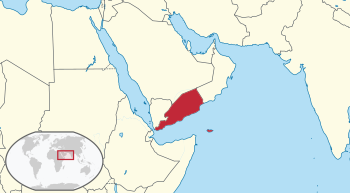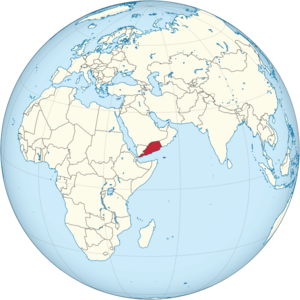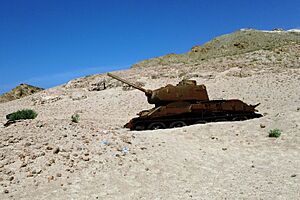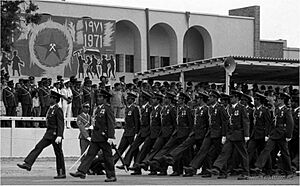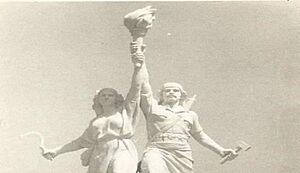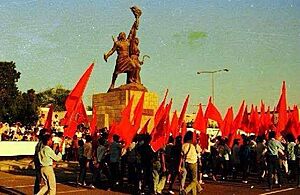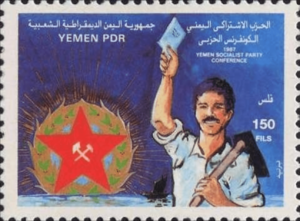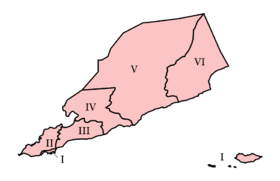South Yemen facts for kids
Quick facts for kids
People's Republic of South Yemen
(1967–1970) جمهورية اليمن الجنوبية الشعبية People's Democratic Republic of Yemen (1970–1990) جمهورية اليمن الديمقراطية الشعبية |
|||||||||||
|---|---|---|---|---|---|---|---|---|---|---|---|
| 1967–1990 | |||||||||||
|
|
|||||||||||
|
Motto: وحدة ، حرية ، إشتراكية
Waḥdah, Ḥurrīyah, Ishtirākīyah ("Unity, Freedom, Socialism") |
|||||||||||
|
Anthem: النشيد الوطني لجمهورية اليمن الديمقراطية الشعبية
An-Našid al-Waṭane al-Jomhuriyat al-Yaman ad-Dimoqrâṭiya aš-Šaʿbiya "National Anthem of People's Democratic Republic of Yemen" |
|||||||||||
| Capital and largest city
|
Aden 12.7855° N, 45.0187° E |
||||||||||
| Official languages | Arabic | ||||||||||
| Religion | Islam | ||||||||||
| Demonym(s) | Yemeni/Yemenite | ||||||||||
| Government | Unitary Marxist–Leninist one-party socialist republic | ||||||||||
| General Secretary | |||||||||||
|
• 1978–1980
|
Abdul Fattah Ismail | ||||||||||
|
• 1980–1986
|
Ali Nasir Muhammad | ||||||||||
|
• 1986–1990
|
Ali Salim al-Beidh | ||||||||||
| President | |||||||||||
|
• 1967–1969 (first)
|
Qahtan al-Shaabi | ||||||||||
|
• 1986–1990 (last)
|
Haidar Abu Bakr al-Attas | ||||||||||
| Prime Minister | |||||||||||
|
• 1969 (first)
|
Faysal al-Shaabi | ||||||||||
|
• 1986–1990 (last)
|
Yasin Said Numan | ||||||||||
| Legislature | Supreme People's Council | ||||||||||
| Independence
from the United Kingdom
|
|||||||||||
| Historical era | Cold War | ||||||||||
|
• Independence declared
|
30 November 1967 | ||||||||||
| 14 December 1967 | |||||||||||
|
• Corrective Move
|
22 June, 1969 | ||||||||||
|
• Constitution adopted
|
31 October 1978 | ||||||||||
|
• Unification
|
22 May 1990 | ||||||||||
| Area | |||||||||||
|
• Total
|
360,133 km2 (139,048 sq mi) | ||||||||||
| Population | |||||||||||
|
• Estimate
|
2,200,000 | ||||||||||
| Currency | South Yemeni dinar (YDD) | ||||||||||
| Driving side | right | ||||||||||
| Calling code | +969 | ||||||||||
| ISO 3166 code | YD | ||||||||||
| Internet TLD | .yd | ||||||||||
|
|||||||||||
| Today part of | Yemen | ||||||||||
|
ISO 3166-1 = YD
ISO 3166-3 = YDYE |
|||||||||||
South Yemen, also known as the People's Democratic Republic of Yemen, was a country in the Middle East. It existed from 1967 to 1990. It was the only communist state in the Middle East and the Arab world.
South Yemen included the southern and eastern parts of what is now the Republic of Yemen. This included the island of Socotra. It shared borders with North Yemen to the northwest, Saudi Arabia to the north, and Oman to the east.
The story of South Yemen began in 1874. That's when the British created the Colony of Aden and the Aden Protectorate. These areas made up about two-thirds of modern-day Yemen. Before 1937, the Colony of Aden was part of British India.
In 1963, a state of emergency was declared. This happened when groups like the National Liberation Front (NLF) fought against British rule. The NLF and another group, the Front for the Liberation of Occupied South Yemen (FLOSY), wanted independence.
The British-controlled areas became the People's Republic of South Yemen on November 30, 1967. After some changes in 1969, it became the People's Democratic Republic of Yemen. It turned into a Marxist–Leninist one-party state. Countries like Cuba, East Germany, North Korea, and the Soviet Union supported it.
South Yemen tried to bring peace to the region. However, it had a short civil war in 1986. On May 22, 1990, South Yemen joined with North Yemen. Together, they formed the Republic of Yemen we know today.
Contents
History of South Yemen
How South Yemen Became Independent
In 1838, a local leader named Muhsin Bin Fadl gave 194 square kilometers (75 square miles) of Aden to the British. On January 19, 1839, the British East India Company took control of Aden. They wanted to stop pirate attacks on British ships going to India. Aden was under British rule from 1839 until 1937.
In the 1920s, the British started to take over small local areas around Aden. They said they were protecting them. This was mainly to stop the Yemeni imams (religious leaders) from attacking Aden. By the mid-1950s, the British realized they couldn't manage their colonies easily. They wanted a stable political group to keep Aden separate from the growing Arab nationalism movement.
So, in 1959, they created the Federation of the Emirates of South Arabia. This plan didn't work well. The British wanted Aden to be part of it, but Aden's business leaders disagreed. Many of them were Indians, Persians, and Jews. They worried about their future under the new system. Also, the local leaders of the smaller areas feared losing their power to the educated people from Aden.
After the Federation of South Arabia was set up in 1965, only four out of twenty-one local areas joined. Some areas, like Qu'aiti and Kathiri in Hadhramaut, refused to join.
Several groups started to fight against British rule. One was the National Liberation Front (NLF). On December 10, 1963, someone from the NLF threw a grenade, injuring a British official. This event started the "October 14 Revolution". This revolution was inspired by a similar one in North Yemen.
The British announced they would leave by 1968 because of the revolution. The NLF and the Front for the Liberation of Occupied South Yemen (FLOSY) became important in the 1960s. The NLF had support from rural areas, while FLOSY was popular in Aden. This was because family ties played a big role in who people supported.
The NLF leaders were from the protected areas and didn't get Egyptian support at first. FLOSY, however, operated from Aden and received help from Gamal Abdel Nasser, Egypt's leader. Their actions against the British were called the Aden Emergency. The British tried to make peace but found themselves fighting two groups. They were trying to stop the new government in the north and the anti-British groups in the south.
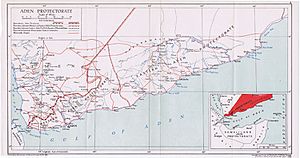
By 1965, the NLF had taken control of most western areas. Hadhramaut remained calm until 1966 because there were fewer British soldiers there. Ali Salem al-Baidh and Haidar Abu Bakr al-Attas joined the NLF in Hadhramaut. They stopped the local leaders of Kathiri and Qu'aiti from entering the country.
In 1966, a commander of a local force was killed. Ali Salem Al-Beidh and Muhammad Salem Akash helped gather support for the NLF. They took advantage of the British absence in Al-Mahra.
Qahtan Al-Shaabi was an agricultural engineer. The British knew him. When the British tried to talk with the NLF, Qahtan demanded that they leave immediately. He also wanted them to recognize his government. He asked for double the aid the British had offered before. He also wanted all islands near Aden to be part of the new country.
The British wanted an orderly handover of power. They also wanted the new country not to interfere in other Arabian Peninsula countries. The British were surprised to see people they thought were loyal to them supporting Qahtan. The NLF was invited to talks in Geneva to sign the independence agreement.
The British had signed protection treaties with local leaders in South Arabia. However, these leaders were not included in the talks. The agreement stated that the territory of South Arabia would be handed over to the NLF.
Southern Yemen became independent as the People's Republic of South Yemen on November 30, 1967. The NLF took firm control of the country. On December 14, 1967, South Yemen joined the United Nations.
The British announced they would leave by 1968. This led to fights between the NLF and FLOSY. Both groups wanted to be the main power after the British left. The NLF gained the upper hand. Many FLOSY members either joined the NLF or left for North Yemen.
The last British soldier left Aden on November 30, 1967. The eastern areas in Hadhramaut were added to the new country. South Yemen's land was rough and dry. This affected its social, cultural, and economic growth. In 1967, its population was less than two million. North Yemen had over six million people. Most people in the south lived in the western areas like Lahj.
Qahtan al-Shaabi became president of a new country with a struggling economy. Many workers and business people left. British support stopped. The closure of the Suez Canal in 1967 reduced ship traffic through Aden by 75%.
The NLF had about 4,000 members. Only a few leaders had university education. None of them had government experience. The NLF was split into two groups: right-wing and left-wing. The right-wing, led by Qahtan, wanted few changes to the economy. They supported freeing Arab lands and helping socialist countries fight colonialism.
The left-wing wanted big social and economic changes. They wanted to help working people instead of the rich. On March 20, 1968, Qahtan removed all leftist leaders from the government. He also stopped a rebellion by leftist army groups in May. In July, August, and December 1968, Qahtan faced more rebellions from leftist groups.
On December 11, 1967, the government took over lands owned by "feudal symbols and British agents." The country was divided into six areas called governorates. This was to reduce tribal power and ignore old tribal borders. On June 16, 1969, Qahtan fired Interior Minister Muhammad Ali Haitham. But Haitham used his connections with tribes and the army. He teamed up with Muhammad Saleh Al-Awlaki. They gathered the leftist forces that Qahtan had scattered. They arrested Qahtan and put him under house arrest.
South Yemen Becomes a Marxist-Leninist State (1969)
On June 22, 1969, a radical group within the NLF took power. This event was called the Corrective Move. A committee of five people, including Salem Rabie Ali (who became president) and Muhammad Ali Haitham (who became prime minister), gained control.
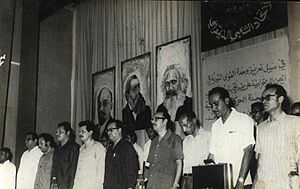
This radical group changed the country's name to the People's Democratic Republic of Yemen (PDRY) on November 30, 1970. All other political groups were combined into the National Liberation Front. It was renamed the Yemeni Socialist Party, becoming the only legal party. This new government followed a strict leftist path. It supported Palestinians and a revolution in Dhofar.
Because South Yemen recognized East Germany, West Germany ended its relationship with the country. The United States also ended its relationship in October 1969. The new leaders created a new constitution. They took over foreign banks and insurance companies. They also set up a centrally planned economy.
The PDRY became very close with the Soviet Union, East Germany, Cuba, and the Palestine Liberation Organization. East Germany's constitution even helped shape South Yemen's first constitution.
The new government started a program of taking over private businesses for the state. They introduced central planning for the economy. They also limited how much housing people could own and controlled rents. Land reforms were put in place. By 1973, South Yemen's economy grew by 25 percent.
Even though the society was traditional, women gained legal equality with men. They were encouraged to work in public. Laws banned polygamy (having more than one spouse), child marriage, and arranged marriages. Women also got equal rights in divorce. The state-supported General Union of Yemeni Women protected these rights.
Education became non-religious, and sharia law (Islamic law) was replaced by a state legal code. Slavery in Yemen, which had been ended in North Yemen in 1962, was now also abolished in South Yemen.
Major communist countries helped build South Yemen's armed forces. The Soviet Union gave strong support. This allowed Soviet naval forces to use naval bases in South Yemen. The most important was a Soviet naval and air base on the island of Socotra. This base was used for operations in the Indian Ocean.
Disputes with North Yemen
Unlike other divided countries, North Yemen and South Yemen usually had friendly relations. However, conflicts did happen. Fighting broke out in 1972. This short war ended with talks, and both sides agreed to eventually unite.
But these plans were put on hold in 1979. South Yemen supported rebel groups in North Yemen. A war was only stopped by other Arab countries stepping in. The goal of unity was confirmed again by both leaders in Kuwait in March 1979.
In 1980, South Yemen's president, Abdul Fattah Ismail, resigned. He went to live in Moscow because the Soviet Union no longer trusted him. His replacement, Ali Nasir Muhammad, was less involved in the affairs of North Yemen and neighboring Oman.
The 1986 Civil War
On January 13, 1986, a violent conflict started in Aden. It was between supporters of Ali Nasir and supporters of Ismail, who had returned and wanted power back. This conflict was called the South Yemen Civil War. It lasted over a month and caused thousands of deaths. Ali Nasir was removed from power, and Ismail disappeared and was believed to have died. About 60,000 people, including Ali Nasir, fled to North Yemen. Ali Salim al-Beidh, who was an ally of Ismail, became the new General Secretary of the Yemeni Socialist Party.
Unification Efforts and Reforms
In the late 1980s, South Yemen started making political changes. This was influenced by reforms happening in the Soviet Union, which was South Yemen's main supporter. Political prisoners were set free. New political parties were allowed to form. The justice system was seen as fairer than in North Yemen.
In May 1988, the governments of North Yemen and South Yemen reached an agreement. This greatly reduced tensions between them. They agreed to talk about unification again. They also decided to create a shared area for oil exploration along their border. The border was made less militarized. Yemenis were allowed to cross the border freely with just a national ID card.
In November 1989, Osama bin Laden offered to send his newly formed al-Qaeda group to overthrow the South Yemeni government. This offer was made on behalf of Saudi Arabia. However, Prince Turki bin Faisal thought the plan was too risky and refused.
In 1990, both sides fully agreed to unite Yemen. The countries officially merged to form the Republic of Yemen.
People of South Yemen
As of 2000, the people of South Yemen were mostly ethnic Yemeni Arabs (92.8%). There were also Somalis (3.7%), Afro-Arabs (1.1%), Indians and Pakistanis (1%), and other groups (1.4%).
Politics and Daily Life
South Yemen became a Marxist–Leninist country. It was mostly non-religious. It was ruled first by the National Liberation Front, which later became the Yemeni Socialist Party.
How the Government Worked
The main law-making body was the Supreme People's Council. Its members were elected by the people for five years. The head of state was a group called the Presidium of the Supreme People's Council. This group was also elected by the Supreme People's Council for five years.
The Council of Ministers was the executive body, which carried out laws. It was formed by the Supreme People's Council. Local people's councils were also important. Their decisions were considered by the Supreme People's Council. Local executive offices helped manage things at the local level.
The highest court was the Supreme Court of South Yemen. Other courts included courts of appeal, provincial courts, and local district courts. The only political party allowed was the Yemen Socialist Party.
Relationships with Other Countries
South Yemen was the only country in the Middle East that openly followed Marxist–Leninist ideas. It received a lot of help from the Soviet Union and East Germany. East Germany even sent hundreds of officers to train South Yemen's secret police. They also helped set up a way to send weapons to Palestine. The East Germans stayed until 1990.
Relations between South Yemen and some nearby countries were not good. Saudi Arabia only started official diplomatic relations in 1976. Before that, Saudi Arabia supported anti-government groups and border conflicts. Relations with Oman worsened in the 1970s. This was because South Yemen supported a Marxist rebel group in Oman. Relations with Ba'athist Iraq were also poor. South Yemen offered a safe place to many Iraqi communists.
The United States listed South Yemen as a "state sponsor of terrorism" from 1979 until Yemen united. Diplomatic relations with the United States were broken on October 24, 1969. This was due to disagreements over US policy in the Middle East. They were not restored until just before unification.
Laws and Courts
The Supreme People's Council was set up by the National Liberation Front in 1971.
In Aden, there was a well-organized court system with a supreme court.
Daily Life and Welfare
Even with a struggling economy, the government made sure everyone had a basic standard of living. It created a welfare state. Income differences became smaller, and corruption was reduced. Health and education services grew. Overall, people were guaranteed a basic but good quality of life.
Sports in South Yemen
In 1976, the South Yemen national football team played in the AFC Asian Cup. They lost to Iraq (1–0) and Iran (8–0). They tried to qualify for the FIFA World Cup in 1986 but were knocked out by Bahrain.
South Yemen played its first international football match on September 2, 1965. They lost 14–0 to the United Arab Republic. Their last international match was on November 5, 1989, when they lost 1–0 to Guinea. The team stopped playing when North and South Yemen united in 1990.
In 1988, the South Yemen Olympic team made its first appearance at the 1988 Summer Olympics in Seoul. They sent only eight athletes and did not win any medals. This was the only time South Yemen went to the Olympics before unification in 1990.
Women's Rights
Under the socialist government, women's rights were considered the best in the region. Women became legally equal to men. They were encouraged to work in public jobs. Laws banned polygamy, child marriage, and arranged marriage. Women also gained equal rights in divorce.
Administrative Divisions
After gaining independence, South Yemen was divided into six governorates (Arabic: muhafazat). These areas had natural borders. From 1967 to 1978, each governorate was given a number. In the mid-1980s, the state changed this. They gave the governorates geographical or historical names. They also made sure the borders did not follow old tribal loyalties. This history still causes some confusion today when people talk about politics in Yemen.
The islands of Kamaran (until 1972, when North Yemen took it), Perim, Socotra, Abd-el-Kuri, Samha (which had people living on it), Darsah, and other uninhabited islands from the Socotra group were districts. They were part of the First/Aden Governorate and were overseen by the Prime Minister.
| Numeral | Name | Approximate Area (km.²) | Capital | |
|---|---|---|---|---|
| I | Aden | 6,980 | Aden | |
| II | Lahij | 12,766 | Lahij | |
| III | Abyan | 21,489 | Zinjibar | |
| IV | Shabwah | 73,908 | Ataq | |
| V | Hadhramawt | 155,376 | Mukalla | |
| VI | Al Mahrah | 66,350 | Al Ghaydah |
Economy of South Yemen

When the British ruled, economic growth in South Yemen was mostly in the city of Aden. It focused on the port and British military bases. So, after the British left, there was little industry or mineral wealth being used. This changed in the mid-1980s when a lot of oil was found. This oil was in the central regions near Shibam and Mukalla.
South Yemen received very little help from other countries. The British government did not keep its promises of aid. The Soviet Union only gave about US$152 million from 1969 to 1980.
The main ways people earned money were through farming and fishing. Farmers grew fruits, cereal crops, and raised cattle and sheep. The government promised full employment in agriculture for people in rural areas. It set up many collective farms. However, farms run like the Soviet model did not do as well as cooperative farms.
In 1976, the national budget was 13.43 million dinars. The total national debt was $52.4 million.
Economic Policies and Changes
South Yemen faced challenges in growing its economy because it had few natural resources. Even so, some oil was found shortly after the country united in 1990. However, the government did not get to use oil exports to pay for its development plans.
Over time, South Yemen's economic policies changed. At first, they focused on developing state-owned businesses. Later, they started to support cooperative and joint private-public businesses. By the late 1980s, there were many factories in Aden and around Al Mukalla. These factories made important goods like plastics, batteries, cigarettes, matches, tomato paste, dairy products, and canned fish.
In the industrial sector, the state put in place welfare laws for workers. These laws were widely followed. For example, they protected women in the workforce by banning night shifts and dangerous jobs for them. The laws also made sure workers earned enough to have a good standard of living. Trade unions in South Yemen mainly worked as state organizations. They helped make sure labor laws and standards were followed.
Oil Discovery
A few months after the 1986 civil war, South Yemen found oil. This was after more than 60 years of trying to find it without success. The Soviet Union found oil in the Shabwah Governorate in late 1986. This was a big moment for the country, which had few resources. For decades, finding oil was hard because of the harsh desert and political problems. South Yemen relied heavily on foreign aid, mostly from the Soviet Union. Money sent home by citizens working abroad made up about half of the government's income by the mid-1980s. The Soviet oil company Technoexport made the discovery during the Cold War.
In the 1980s, Technoexport signed a deal with South Yemen to look for oil in a large area in Shabwa. In 1984, they started drilling. For two years, this Soviet effort found only small amounts of oil. This was different from an American company, Hunt Oil, which quickly found and used oil in North Yemen's Marib basin during the same time. Then, in late 1986, the Soviets found very high-quality oil in western Shabwa. South Yemen's government confirmed this in early 1987.
By late March, early estimates suggested there were about 1 billion barrels of oil. Plans were made to build pipelines and start full oil production. By mid-1987, industry sources reported that three oil fields could produce 10,000 barrels of oil per day. Between 5,000 and 10,000 barrels per day were being trucked to the Aden refinery. There were plans to increase the number of trucks to deliver up to 25,000 barrels per day. This was much more than South Yemen needed for its own use at the time. The oil discovery was seen as a way to rely less on foreign money and improve the lives of South Yemen's 2.4 million people. However, the discovery also brought many challenges.
Western Shabwa was not the only area where oil was being searched for. The Soviet Union was not the only company looking for oil in the late 1980s. The Deputy Prime Minister said in late 1987 that eight Western and Arab companies were looking for oil in several areas in South Yemen. Companies like Brazil's Braspetrol, France's Elf Aquitaine and Total, Kuwait's Independent Petroleum Group, and Canadian Occidental were actively searching for oil.
The Soviet Union's involvement in the oil discovery cost over half a billion dollars. This added to South Yemen's already large debt. It also raised concerns about possible political and economic influence in the region. The oil discovery also made the relationship between South and North Yemen more complicated. Both wanted to unite and saw the oil as a way to become richer.
South Yemen was also dealing with internal political struggles and social unrest when the oil was found. A violent power struggle within the ruling communist party in January 1986 made the country even more unstable. This difficult political situation cast a shadow over the potential benefits of the new oil wealth. It also raised questions about how the resources would be managed and shared fairly.
Airlines of South Yemen
The following airlines operated from South Yemen:
- Aden Airways (1949–1967). This airline stopped flying on June 30, 1967, when the British left.
- Alyemda – Democratic Yemen Airlines (1961–1996). This airline later joined Yemenia, the airline of the former North Yemen.
- The Brothers Airline Service Corporation (BASCO) was a short-lived airline.
See also
- South Yemen Movement
- South Yemen insurgency
- Dhofar Rebellion
- STC
- Yemen




